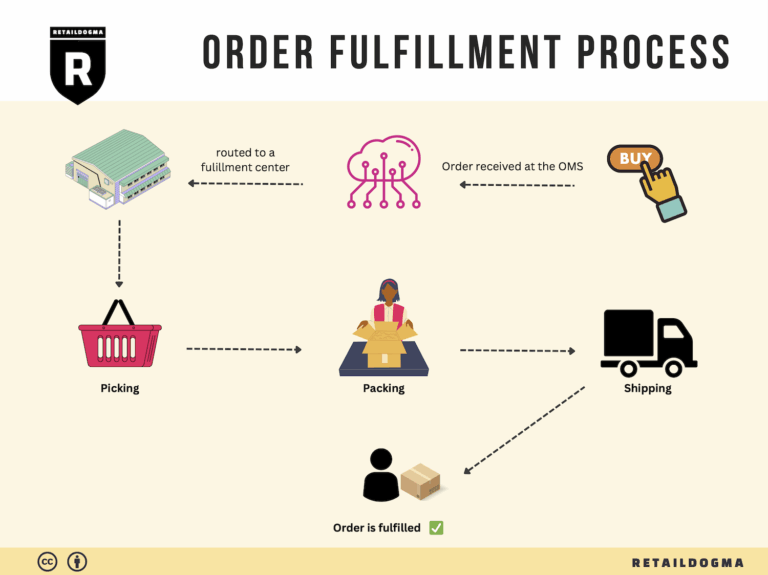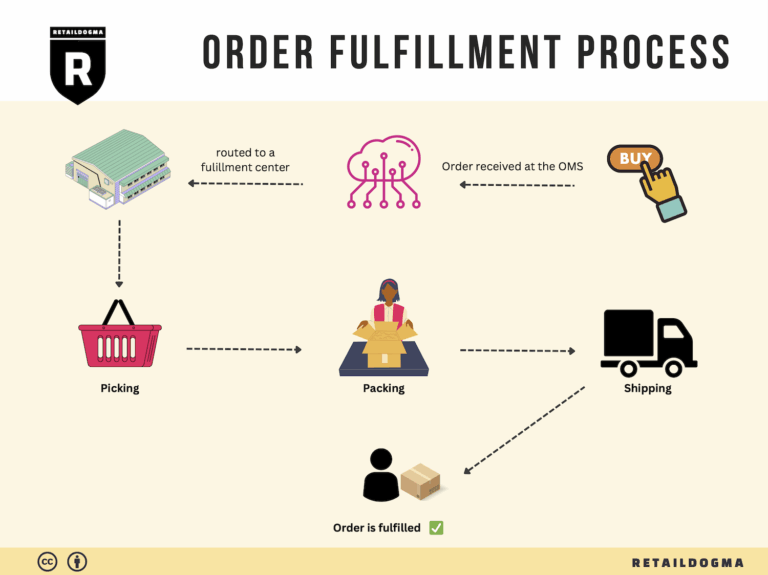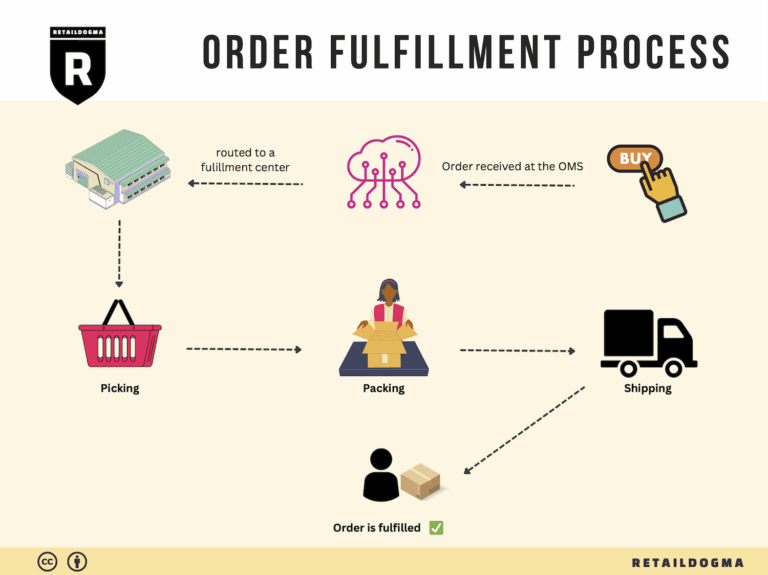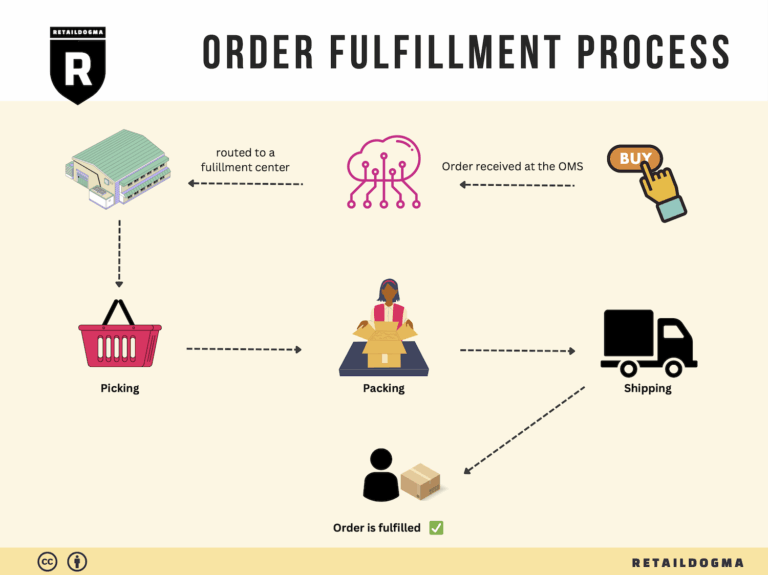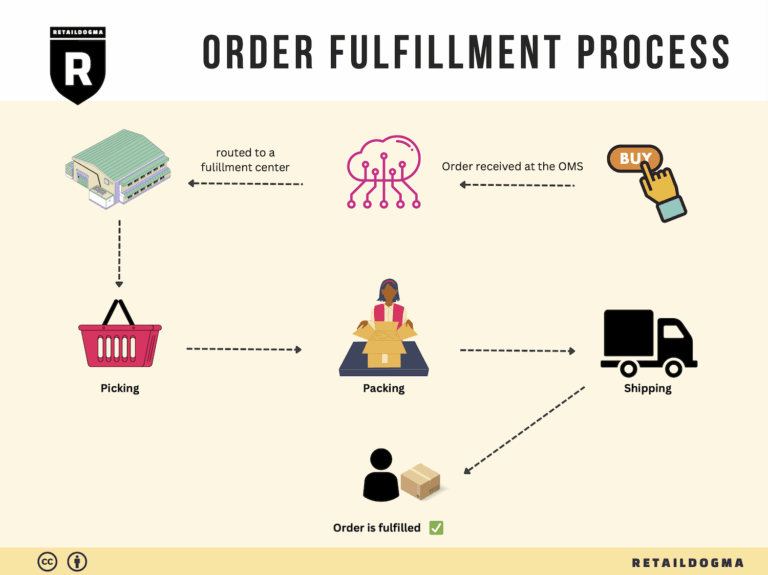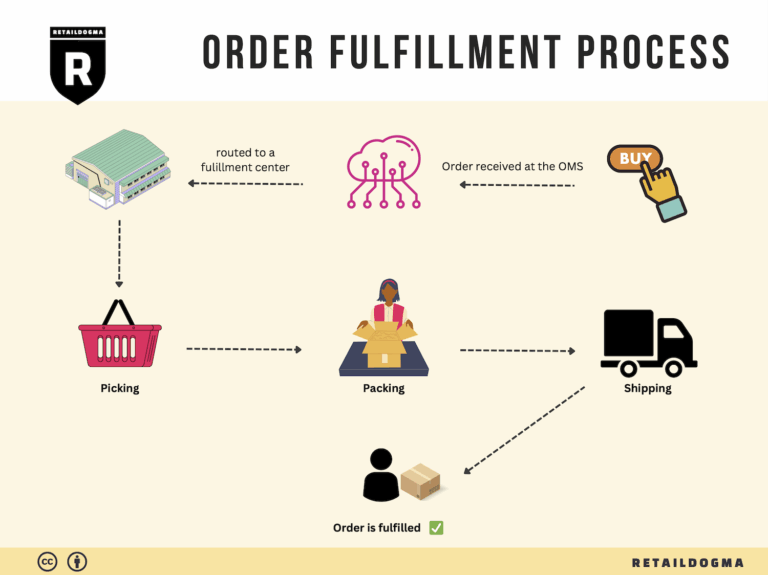How Order Fulfillment Works: A Step-by-Step Guide for Businesses
What is E-commerce Fulfillment? An Introduction for Growing Businesses
Understanding the Fulfillment Challenge in E-commerce
As an e-commerce business owner, one of the most significant hurdles you may face is managing the logistics of packing and shipping orders. When your sales begin to grow, the sheer volume of orders can quickly become overwhelming. This often leads to inefficiencies, increased costs, and frustrated customers who expect their products to arrive quickly and in good condition.
Fulfillment, at its core, is the process of getting a product into the hands of a customer. This includes everything from inventory management and order processing to picking, packing, and shipping. For many growing businesses, mastering this process is crucial not only for customer satisfaction but also for overall operational efficiency and profitability.
What This Guide Will Cover
In this guide, we will explore the various models of e-commerce fulfillment available to businesses today. We will delve into the differences between using a third-party logistics provider (3PL) and Fulfillment by Amazon (FBA), two popular options that can help streamline your operations. Each model has its own set of advantages and disadvantages, making it essential to understand which one aligns best with your business needs.
Additionally, we will outline the core services involved in fulfillment, such as inventory storage, order picking, packing, shipping, and returns management. Each service plays a critical role in ensuring that your customers receive their orders promptly and accurately.
Choosing the right fulfillment partner can significantly impact your business’s scalability and success. We will provide practical advice on how to evaluate potential partners based on factors like technology, service levels, and cost structures. Understanding pricing models will also be a key focus, as costs can vary widely between different fulfillment options.
Empowering Your Business Decisions
The ultimate goal of this guide is to empower you to make informed decisions about your logistics strategy. By understanding the various fulfillment options and their implications for your business, you can better position yourself to meet customer expectations while optimizing your operational efficiency. In an increasingly competitive e-commerce landscape, mastering fulfillment could be the difference between merely surviving and thriving.
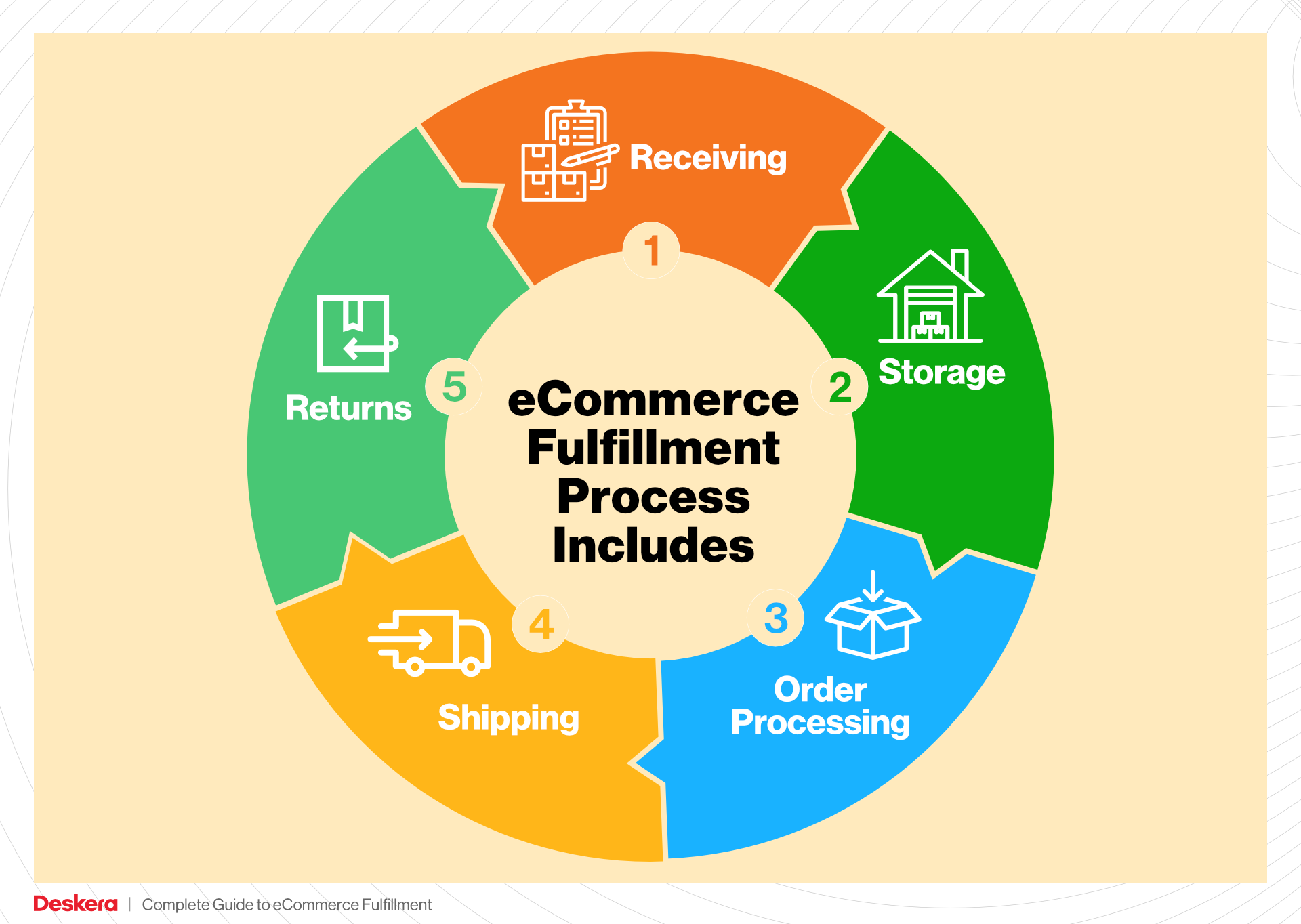
What You’ll Learn In This Guide
- What is E-commerce Fulfillment? An Introduction for Growing Businesses
- The Order Fulfillment Process: From ‘Buy’ Button to Customer’s Door
- Comparing Fulfillment Models: In-House vs. 3PL vs. Dropshipping
- A Deep Dive into Amazon FBA: Pros, Cons, and Who It’s For
- Core Services Offered by Fulfillment Centers
- How to Choose a Fulfillment Partner: A 6-Point Checklist
- Understanding Fulfillment Pricing: A Breakdown of Common Fees
- Frequently Asked Questions (FAQs) about Fulfillment
- Conclusion: Is Outsourcing Fulfillment the Right Move for Your Business?
- Important Disclaimer
The Order Fulfillment Process: From ‘Buy’ Button to Customer’s Door
1. Receiving Inventory
The order fulfillment process begins with receiving inventory from suppliers or manufacturers. During this step, products arrive at the warehouse and need to be checked against purchase orders to ensure accuracy. This involves verifying quantities, inspecting for damages, and confirming that the correct items have been received.
Importance: This step is crucial because it sets the foundation for the entire fulfillment process. Accurate receiving minimizes errors downstream, reduces returns, and ensures that inventory levels are correctly updated.
Key Term: SKU (Stock Keeping Unit). An SKU is a unique identifier assigned to each product, allowing for efficient tracking and management of inventory. When receiving inventory, each item’s SKU must be recorded to ensure accurate inventory counts and easy retrieval later in the process.
2. Warehouse Storage
Once inventory is received and verified, it is stored in the warehouse. Effective warehouse storage involves organizing products in a systematic manner, often categorized by SKU, size, or product type. This could mean using shelving units, bins, or pallets, depending on the nature of the products.
Importance: Proper storage is vital for maximizing warehouse efficiency and ensuring that items can be retrieved quickly when orders are placed. Well-organized storage not only enhances operational efficiency but also reduces the time taken for order picking, which is essential for meeting customer expectations regarding delivery times.
Key Term: FIFO (First In, First Out). FIFO is a method used in inventory management where the oldest stock is sold first. This is especially important for perishable goods or items with expiration dates to minimize waste and ensure product freshness.
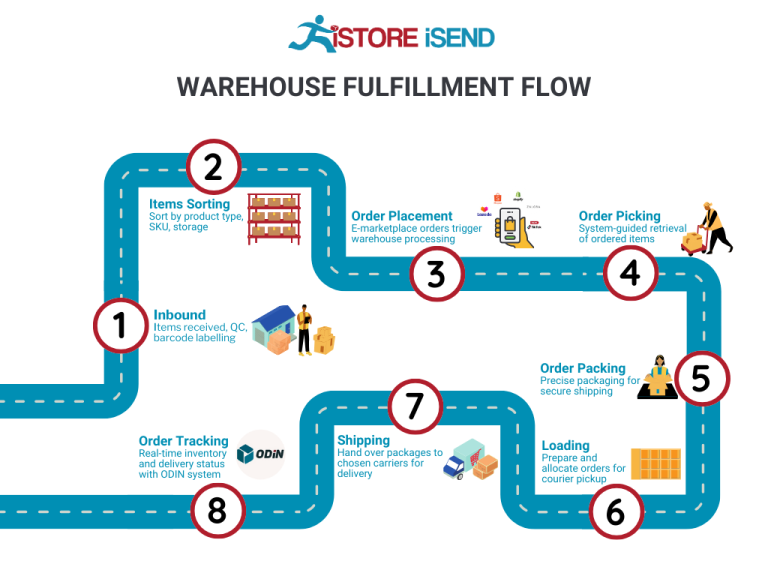
3. Order Picking
The next step is order picking, where warehouse staff retrieve items from storage to fulfill customer orders. This process can be done manually or with the aid of technology, such as pick-to-light systems or mobile devices that guide employees to the correct locations.
Importance: Order picking is one of the most labor-intensive and time-consuming aspects of fulfillment. Efficiency in this step directly impacts the speed of order processing and customer satisfaction. Streamlining this process through optimized routes or technology can significantly improve productivity.
Key Term: Pick Lists. A pick list is a document or digital tool that outlines the items to be collected for each order. It typically includes SKUs, item descriptions, and quantities, serving as a critical tool for ensuring accuracy and efficiency during the picking process.
4. Order Packing
After items are picked, they must be packed for shipment. This involves selecting appropriate packaging materials, securely placing items within boxes, and including any necessary documentation (like invoices or packing slips).
Importance: The packing step is crucial for protecting products during transit and ensuring that they arrive at the customer’s door in excellent condition. Proper packing can also enhance the unboxing experience, which is increasingly important in e-commerce.
Key Term: DIM Weight (Dimensional Weight). DIM weight is a pricing technique used by carriers that takes into account the volume of a package rather than just its weight. Understanding DIM weight is essential for choosing the right box sizes and optimizing shipping costs.
5. Shipping & Delivery
The final step in the order fulfillment process is shipping and delivery. Once packed, orders are labeled and handed over to shipping carriers. This step involves choosing the right shipping method based on factors like delivery speed, cost, and destination.
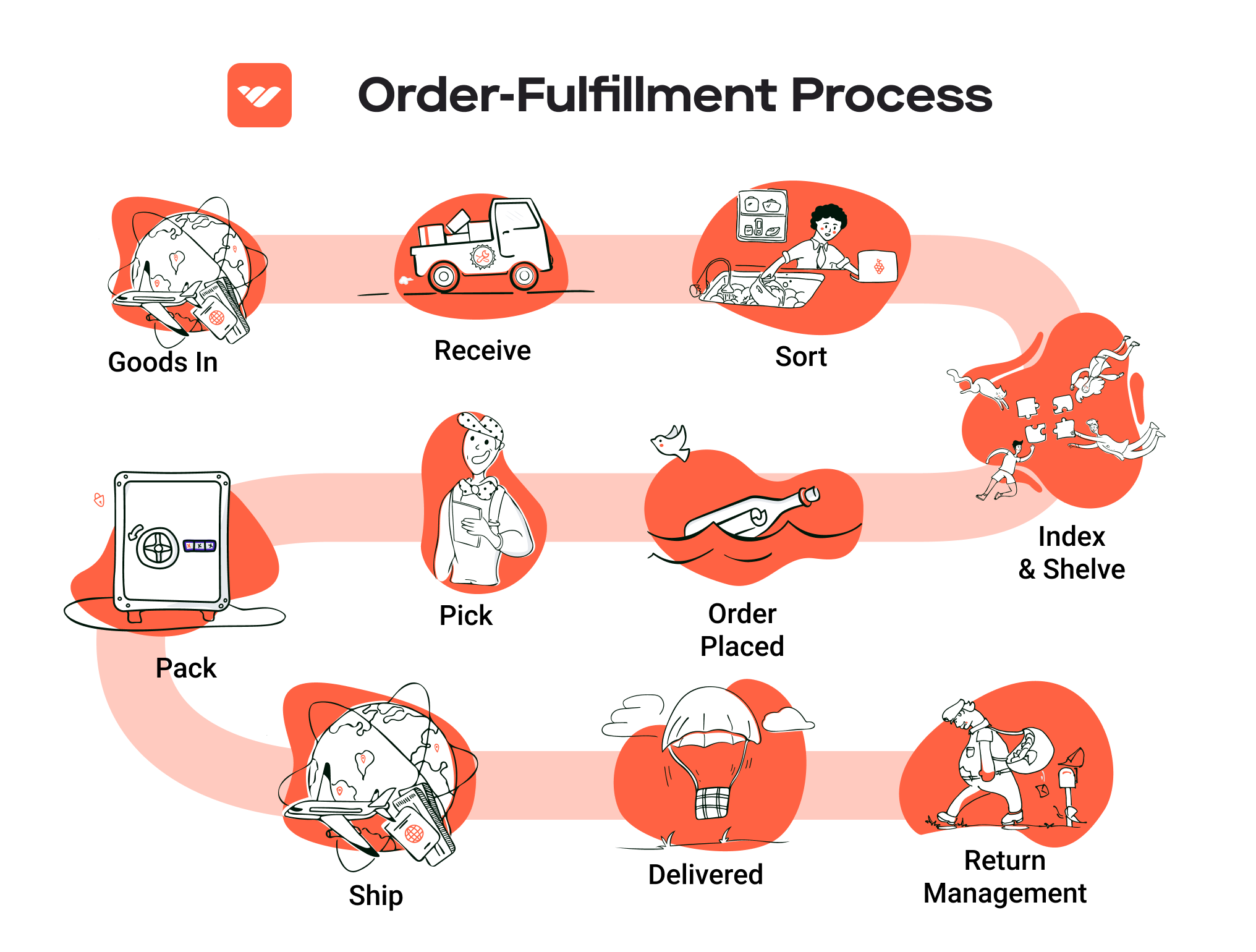
Importance: Efficient shipping and delivery are critical for maintaining customer satisfaction. With the rise of e-commerce, customers expect fast and reliable delivery options. Businesses need to develop partnerships with carriers to ensure that they can meet these expectations while keeping shipping costs manageable.
Key Term: Last-Mile Delivery. Last-mile delivery refers to the final step of the shipping process, where the package is delivered from the distribution center to the customer’s doorstep. This phase is often the most complex and costly part of the shipping process, making it a crucial focus area for e-commerce businesses aiming to enhance customer experience.
In conclusion, mastering the order fulfillment process from receiving inventory to shipping and delivery is essential for e-commerce businesses. By understanding each step and its significance, entrepreneurs can streamline operations, reduce costs, and improve customer satisfaction, ultimately leading to scalable growth in their sales and logistics efforts.
Comparing Fulfillment Models: In-House vs. 3PL vs. Dropshipping
Fulfillment Model Comparison
| Model | Who Handles Inventory | Best For (Business Stage) | Key Advantage | Key Disadvantage |
|---|---|---|---|---|
| In-House Fulfillment | The business itself | Established businesses with stable sales | Full control over operations and inventory | High overhead costs and resource-intensive |
| Third-Party Logistics (3PL) | 3PL provider | Growing businesses seeking scalability | Access to expertise and reduced logistics burden | Less control over inventory and potential hidden fees |
| Dropshipping | Supplier | Startups and businesses with limited capital | Low overhead and no inventory management required | Lower profit margins and reliance on supplier reliability |
In-House Fulfillment
In-house fulfillment involves managing the entire logistics process within your own organization. This model allows businesses to maintain complete control over their inventory, from storage and picking to packing and shipping. Businesses that opt for in-house fulfillment typically have an established customer base and a steady volume of sales that justifies the investment in warehouse space, staffing, and logistics technology. The primary advantage of this model is the level of control it offers, enabling businesses to customize their processes to meet specific customer needs and enhance their brand experience. However, it comes with significant drawbacks, including high overhead costs, the need for substantial resources, and potential operational inefficiencies. As a business scales, managing logistics internally can become cumbersome, requiring ongoing investment in infrastructure and personnel.
Third-Party Logistics (3PL)
Third-party logistics (3PL) providers offer a flexible solution for businesses looking to outsource their fulfillment needs. By partnering with a 3PL, businesses can leverage the provider’s expertise, technology, and infrastructure to manage inventory, warehousing, and distribution. This model is particularly beneficial for growing businesses that experience fluctuating order volumes or are looking to expand into new markets without incurring the high costs of maintaining their own fulfillment operations. The key advantage of using a 3PL is the ability to focus on core business activities while leaving logistics to experts who can scale operations as needed. However, this model does come with its challenges, such as reduced control over inventory management and potential hidden fees that can arise from service agreements. Businesses must carefully evaluate 3PL partners to ensure alignment with their operational goals and customer service standards.
Dropshipping
Dropshipping is a fulfillment model that allows businesses to sell products without holding any inventory. In this model, the retailer takes orders from customers and then passes those orders to a supplier or manufacturer, who ships the products directly to the customer. This approach is particularly attractive for startups and small businesses that may have limited capital and want to minimize upfront investment in inventory. The primary advantage of dropshipping is the low overhead costs, as businesses do not need to manage inventory, warehousing, or shipping logistics. However, dropshipping also has significant disadvantages, including lower profit margins and a reliance on suppliers for product availability and shipping reliability. Retailers may face challenges in maintaining quality control and ensuring timely delivery, which can impact customer satisfaction. As such, while dropshipping can be a viable entry point into e-commerce, businesses should be aware of the potential risks and work to establish strong relationships with reliable suppliers.
In conclusion, selecting the right fulfillment model is crucial for e-commerce success. Each option—In-House Fulfillment, Third-Party Logistics, and Dropshipping—offers distinct advantages and challenges. By carefully considering their business stage, resource availability, and customer expectations, e-commerce business owners can choose a fulfillment strategy that aligns with their operational goals and sets the stage for growth.
A Deep Dive into Amazon FBA: Pros, Cons, and Who It’s For
Understanding Fulfillment by Amazon (FBA)
Fulfillment by Amazon (FBA) is a service offered by Amazon that allows third-party sellers to leverage Amazon’s vast logistics network to store, pick, pack, and ship their products directly to customers. By utilizing FBA, sellers can store their inventory in Amazon’s fulfillment centers, and Amazon takes care of the entire fulfillment process, including customer service and returns management. This service is particularly advantageous for e-commerce businesses looking to scale their operations without the complexities of managing their logistics.
How FBA Works
When a seller enrolls in FBA, they send their products to Amazon’s fulfillment centers. Once the products are stored, they become eligible for Amazon Prime, which allows them to reach a wider audience of Prime members who seek fast and reliable shipping options. When a customer places an order for an FBA product, Amazon handles the order fulfillment—picking the item from the warehouse, packing it, and shipping it directly to the customer. Additionally, Amazon manages customer inquiries and returns related to those orders, providing a seamless experience for both sellers and buyers.
Pros of FBA
1. Prime Eligibility
One of the most significant advantages of FBA is the eligibility for Amazon Prime. Products fulfilled through FBA are automatically included in the Prime program, which attracts millions of loyal customers who prefer to shop for items that can be delivered quickly (often within two days). This can significantly boost sales as Prime members tend to spend more than non-members.
2. Customer Trust
FBA products benefit from the trust associated with Amazon’s brand. Customers often feel more secure purchasing items that are fulfilled by Amazon due to their established reputation for reliability, fast shipping, and excellent customer service. This trust can lead to higher conversion rates and repeat purchases.
3. Multi-Channel Fulfillment
FBA is not limited to Amazon’s marketplace. Sellers can use FBA to fulfill orders from other sales channels, such as their own e-commerce websites or other online marketplaces. This multi-channel fulfillment capability allows businesses to streamline their logistics and manage their inventory more efficiently, ultimately enhancing customer satisfaction across platforms.
4. Reduced Operational Burden
By outsourcing fulfillment to Amazon, sellers can focus more on core business activities such as product development and marketing rather than managing logistics. This can be particularly beneficial for small and medium-sized enterprises (SMEs) that may lack the resources to handle warehousing and shipping independently.
5. Advanced Logistics Technology
Amazon’s robust logistics infrastructure includes state-of-the-art technology and systems that optimize inventory management and order processing. This can lead to increased efficiency and reduced delivery times, which are critical components of customer satisfaction in e-commerce.
Cons of FBA
1. High Fees
While FBA can simplify logistics, it comes at a cost. Amazon charges various fees for storage, fulfillment, and additional services. These fees can significantly cut into profit margins, especially for sellers with slow-moving inventory. It’s crucial for businesses to conduct thorough financial analysis to understand the impact of these fees on their pricing and profitability.
2. Strict Inventory Management Rules
Sellers must adhere to Amazon’s strict inventory policies, which include limitations on storage space and requirements for inventory turnover. If products remain in Amazon’s warehouses for too long, sellers may incur long-term storage fees. This can create pressure on sellers to manage their inventory effectively and may lead to challenges in forecasting demand.
3. Commingling Risks
FBA operates on a commingling model, meaning that products from various sellers can be stored together. This can lead to complications, such as receiving returns for items that were not originally sold by the seller or issues with product authenticity. Sellers must weigh the risks associated with commingling against the benefits of using FBA.
4. Loss of Control
When using FBA, sellers relinquish some control over their fulfillment process. Issues such as inventory mismanagement or shipping delays can occur, and sellers may find it challenging to resolve these problems quickly. This lack of direct oversight can be a concern for businesses that prioritize a high level of customer service.
5. Dependence on Amazon’s Policies
Sellers using FBA are subject to Amazon’s ever-changing policies and algorithms. Any modifications to FBA rules, fees, or the Buy Box eligibility criteria can directly impact a seller’s business. Staying updated on these changes is crucial, but it can also be a source of stress and uncertainty.
Who is FBA Best For?
Fulfillment by Amazon is particularly well-suited for:
- Small to Medium-Sized Businesses: Companies that lack the infrastructure or resources to handle logistics can benefit significantly from outsourcing to Amazon.
- Brands Seeking Rapid Growth: Businesses looking to scale quickly and efficiently can tap into Amazon’s vast customer base and logistics capabilities.
- Sellers with Fast-Moving Products: FBA is ideal for products that have high demand and turnover, as the associated fees can be more manageable with quick sales.
- E-commerce Entrepreneurs: New entrants to the e-commerce space can leverage FBA to simplify logistics while focusing on marketing and customer acquisition.
In conclusion, while Fulfillment by Amazon offers numerous advantages, including access to Prime customers and reduced operational burdens, it is essential for sellers to carefully consider the associated costs and potential risks. By weighing these factors, e-commerce business owners can determine if FBA aligns with their growth strategies and operational capabilities.
Core Services Offered by Fulfillment Centers
Inventory Management & Warehousing
Inventory management and warehousing are foundational services provided by fulfillment centers. This involves not only storing products but also maintaining optimal stock levels, tracking inventory in real-time, and ensuring that products are organized efficiently within the warehouse.
What It Is:
Fulfillment centers utilize advanced inventory management systems that allow e-commerce businesses to monitor stock levels, manage reorders, and receive alerts for low inventory. These systems can integrate with various e-commerce platforms, providing businesses with a seamless flow of information regarding their inventory.
Benefits:
1. Efficiency in Stock Control: By leveraging sophisticated inventory management tools, businesses can minimize the risk of stockouts or overstock situations, which can tie up capital and increase storage costs.
2. Real-Time Data Access: E-commerce businesses gain visibility into their inventory levels and turnover rates, enabling better forecasting and strategic planning.
3. Cost Reduction: Efficient inventory management can lead to lower holding costs and improved cash flow, as businesses only hold the necessary stock to meet customer demand.
Pick and Pack Services
Pick and pack services are crucial for the order fulfillment process, where items are selected from inventory (picked) and packaged for shipment (packed).
What It Is:
When an order is placed, fulfillment center staff retrieve the ordered items from storage, assemble them, and prepare them for delivery. This process often involves multiple items being packaged together to optimize shipping costs and enhance customer experience.
Benefits:
1. Speedy Order Processing: Fulfillment centers employ streamlined processes and technology to ensure quick turnaround times for order fulfillment, which is critical for customer satisfaction.
2. Accuracy: Advanced picking systems reduce human error, ensuring that the correct items are shipped to customers. This increases customer trust and reduces return rates.
3. Scalability: As e-commerce businesses grow, fulfillment centers can easily scale their pick and pack operations to handle increased order volumes without the need for significant investment in infrastructure or labor.
Kitting and Assembly
Kitting and assembly services involve the grouping of individual items into ready-to-ship sets or the assembly of products before they are sent to customers.
What It Is:
In this service, fulfillment centers take multiple products and combine them into a single package or kit. This could include items that are sold together as a bundle or products that require assembly before shipping.
Benefits:
1. Enhanced Customer Experience: By offering pre-assembled kits, businesses can provide customers with a convenient shopping experience, encouraging higher purchase volumes and customer satisfaction.
2. Cost Efficiency: Bundling products can reduce shipping costs and improve the overall value proposition for customers, making it more attractive for them to purchase multiple items at once.
3. Inventory Optimization: Kitting allows businesses to manage inventory more effectively by combining slow-moving items with popular products, reducing excess stock and improving overall sales.
Returns Management (Reverse Logistics)
Returns management, or reverse logistics, is the process of handling returned goods efficiently and effectively. This service is increasingly important in the e-commerce landscape, where return rates can be significant.
What It Is:
Fulfillment centers provide a streamlined process for handling returns, including inspecting returned items, restocking them if they are in good condition, and managing the disposal of damaged goods. This process often includes the generation of return shipping labels and the communication of return policies to customers.
Benefits:
1. Customer Satisfaction: Efficient returns management can enhance customer loyalty, as consumers are more likely to shop with businesses that offer hassle-free return processes.
2. Cost Control: By managing returns effectively, businesses can minimize the costs associated with processing returns, such as shipping and restocking fees, and reduce the impact on inventory levels.
3. Data Insights: Returns management provides valuable data on customer preferences and product issues, allowing businesses to make informed decisions about product quality and inventory strategies.
In conclusion, fulfillment centers provide a range of core services that enable e-commerce businesses to streamline their operations, enhance customer experiences, and scale effectively. By leveraging these services, businesses can focus on their core competencies—such as marketing and product development—while leaving the complexities of logistics to the experts.
How to Choose a Fulfillment Partner: A 6-Point Checklist
Location & Warehouse Network
Importance: The location of your fulfillment partner’s warehouses can significantly impact shipping times and costs. A strategically positioned warehouse network allows for quicker deliveries, which is crucial for customer satisfaction and can enhance your competitiveness, especially in an era where consumers expect rapid shipping.
Questions to Ask:
– What is the geographic coverage of your warehouse network?
– How close are your warehouses to my primary customer base?
– Do you have the ability to open additional warehouses if my business scales?
– How do you manage inventory across multiple locations?
Technology & Integrations
Importance: In today’s e-commerce landscape, technology is a vital component of efficient order fulfillment. A partner with robust technology can automate processes, provide real-time tracking, and integrate seamlessly with your existing systems (e.g., your e-commerce platform, ERP, or CRM). This reduces manual errors and enhances operational efficiency.
Questions to Ask:
– What fulfillment technology do you use, and how does it streamline your processes?
– Do you offer APIs or integrations with major e-commerce platforms (like Shopify, Amazon, etc.)?
– Can you provide real-time inventory updates and tracking for both me and my customers?
– How do you handle data security and compliance?
Specializations (e.g., Cold Storage, Oversized Items)
Importance: Depending on the nature of your products, certain fulfillment centers may be better suited to handle specific needs such as cold storage for perishables, fragile items, or oversized products. Understanding these specializations can save you time, reduce damage rates, and ensure compliance with regulations.
Questions to Ask:
– What types of specializations do you offer (e.g., cold storage, hazardous materials, oversized items)?
– How do you ensure the integrity and safety of specialized products during storage and handling?
– What experience do you have with businesses in my industry or with similar products?
– Can you accommodate seasonal fluctuations in demand for specialized items?
Scalability & Capacity
Importance: As your business grows, your fulfillment partner should be able to scale alongside you. Whether it’s accommodating increased order volumes during peak seasons or expanding your product lines, your partner should have the capacity to adapt quickly to your changing needs.
Questions to Ask:
– What is your current capacity, and how do you manage peak seasons?
– How quickly can you scale operations if my order volume increases?
– Are there any limitations or constraints I should be aware of regarding your capacity?
– What processes do you have in place to ensure a smooth transition during scaling?
Pricing and Contracts
Importance: Understanding the pricing structure and contract terms of your fulfillment partner is crucial to managing costs effectively. A transparent pricing model helps you budget accurately and avoid unexpected fees. Additionally, contract flexibility is important to accommodate business changes.
Questions to Ask:
– Can you provide a detailed breakdown of your pricing structure (e.g., storage fees, pick and pack fees, shipping costs)?
– Are there any hidden fees or charges I should be aware of?
– What are the terms of the contract, and how flexible are they in case my needs change?
– Do you offer volume discounts or incentives for long-term partnerships?
Customer Support & Reviews
Importance: Reliable customer support is essential for resolving issues quickly and maintaining a smooth operation. Furthermore, checking reviews and testimonials can provide insights into the partner’s reliability and quality of service, helping you gauge whether they will meet your expectations.
Questions to Ask:
– What kind of customer support do you offer (e.g., dedicated account manager, 24/7 support)?
– Can you provide references or case studies from businesses similar to mine?
– How do you handle issues such as order inaccuracies, delays, or inventory discrepancies?
– What feedback mechanisms are in place for me to voice concerns or suggestions?
Conclusion
Choosing the right fulfillment partner is a critical decision that can have lasting impacts on your e-commerce business’s success. By using this checklist to evaluate potential partners, you can ensure that you select a provider that aligns with your operational needs, facilitates growth, and enhances customer satisfaction. Remember, the right partner can not only streamline your logistics but also contribute significantly to your overall business strategy.
Understanding Fulfillment Pricing: A Breakdown of Common Fees
Initial Setup Fees
Initial setup fees are typically charged when a seller first engages with a fulfillment service. These fees can cover a variety of costs, including account setup, integration with e-commerce platforms, and initial inventory assessment. The amount charged can vary significantly based on the complexity of the integration and the specific requirements of the seller’s business.
- Calculation: Generally, initial setup fees can range from a few hundred to several thousand dollars. The exact fee often depends on the fulfillment provider’s pricing structure and the level of customization needed. Some providers may offer promotional rates or waive these fees for high-volume sellers, so it’s crucial to negotiate.
Receiving Fees
Receiving fees are incurred when inventory is delivered to the fulfillment center. These fees cover the labor and equipment costs associated with unloading, inspecting, and storing the products in the warehouse. This step is critical as it ensures that the inventory is accounted for and in sellable condition.
- Calculation: Receiving fees can be charged per pallet or per item, depending on the fulfillment provider’s pricing model. For instance, a provider might charge $25 per pallet or $0.50 per item received. It’s advisable to clarify whether these fees apply to all types of shipments, including returns or damaged goods, as this can impact overall costs.
Storage Fees (per pallet/bin)
Storage fees are charged for the space that your inventory occupies in the fulfillment center. This is a recurring fee that can be assessed monthly or quarterly and is essential for managing the costs of holding inventory.
- Calculation: Storage fees are often calculated based on the volume of space your products occupy, typically measured in cubic feet or pallets. For example, a common model might charge $15 per pallet per month. Some providers also implement tiered pricing, where the rate decreases after a certain volume threshold is reached. Additionally, be aware that many providers impose higher fees for long-term storage, incentivizing sellers to manage their inventory efficiently.
Pick & Pack Fees (per item/order)
Pick and pack fees cover the labor involved in retrieving items from storage and preparing them for shipment. This process includes picking the correct items, packing them securely, and labeling them for delivery. Efficient pick and pack processes are crucial for maintaining fast shipping times and customer satisfaction.
- Calculation: These fees can vary widely based on the complexity of the order and the fulfillment provider. A typical pick and pack fee might range from $1 to $3 per item, with some providers offering flat rates per order. It’s essential to understand whether the pick fee is charged separately from the pack fee, as this can significantly affect total fulfillment costs, especially for orders with multiple items.
Shipping Fees
Shipping fees are the costs associated with transporting the packed orders to the customers. This includes both domestic and international shipping costs, which can fluctuate based on factors such as package weight, dimensions, and delivery speed.
- Calculation: Shipping fees are typically calculated based on weight and destination. Some fulfillment centers may offer discounted shipping rates due to their volume of shipments, which can be advantageous for sellers. Additionally, providers often allow sellers to choose between different shipping options (e.g., standard, expedited) that can affect the final cost. It’s crucial to evaluate the shipping options available and factor these into your overall fulfillment budget.
Tips for Getting an Accurate Quote
-
Be Transparent: When requesting quotes from fulfillment providers, provide detailed information about your inventory, order volume, and specific needs. This transparency helps providers give you the most accurate estimate possible.
-
Ask About Hidden Fees: Ensure you ask about any potential hidden fees, such as those for returns, damaged inventory, or long-term storage, as these can significantly impact your overall costs.
-
Compare Multiple Providers: Don’t settle for the first quote you receive. Compare offerings from multiple fulfillment providers to ensure you’re getting a competitive rate.
-
Negotiate: Many fulfillment providers are open to negotiation, especially if you can demonstrate high sales potential or are willing to commit to a long-term contract.
-
Consider Total Cost of Ownership: Look beyond just the initial quotes. Factor in the total cost of ownership, including all fees over time, to understand the long-term financial implications of your fulfillment choice.
By understanding these common fees and how they are calculated, e-commerce business owners can better navigate the complexities of fulfillment pricing and make informed decisions that align with their growth strategies.
Frequently Asked Questions (FAQs) about Fulfillment
1. What is Fulfillment by Amazon (FBA)?
Fulfillment by Amazon (FBA) is a service that allows e-commerce sellers to store their products in Amazon’s fulfillment centers. Amazon takes care of the picking, packing, shipping, and customer service, enabling sellers to reach a broader audience, particularly Amazon Prime members, without the complexities of logistics management.
2. How does FBA benefit my e-commerce business?
FBA can significantly enhance your business by providing quick and reliable shipping options, access to Amazon’s customer service, and the opportunity to be eligible for the Buy Box—a crucial feature for visibility on Amazon. This service allows you to focus on scaling your business while Amazon handles the logistics.
3. What are the costs associated with using FBA?
FBA fees include storage fees for your inventory, fulfillment fees based on the size and weight of your products, and additional charges for long-term storage. As of 2023, these fees can account for up to 50% of the sales price for some sellers, so it’s essential to factor these costs into your pricing strategy.
4. What’s the difference between a warehouse and a fulfillment center?
A warehouse primarily focuses on storing products, while a fulfillment center is designed for order processing, including picking, packing, and shipping products directly to customers. Fulfillment centers are equipped to handle logistics efficiently, which is crucial for e-commerce operations.
5. What is a Third-Party Logistics (3PL) provider?
A Third-Party Logistics (3PL) provider is a company that offers outsourced logistics services to e-commerce businesses. This can include warehousing, order fulfillment, shipping, and returns management. Utilizing a 3PL can help businesses streamline operations and reduce overhead costs, especially for those not ready to manage their fulfillment in-house.
6. How do I choose between FBA and a 3PL?
Choosing between FBA and a 3PL depends on your business needs. FBA is ideal for sellers looking to leverage Amazon’s infrastructure and customer base, while a 3PL may be more suitable for those wanting greater control over their logistics, including branding and customer experience. Evaluate factors such as cost, scalability, and fulfillment speed to make the best decision.
7. How long does it take for products to be delivered through FBA?
FBA typically offers fast shipping options, including same-day or two-day delivery for Prime members. However, delivery times can vary based on the customer’s location, the time of year (e.g., holiday seasons), and the specific shipping method selected.
8. What happens if my inventory runs out in FBA?
If your inventory runs out, your products will become unavailable for sale on Amazon until you restock. This can negatively impact your sales and rankings, so it’s crucial to monitor your inventory levels closely and replenish stock proactively to maintain visibility and sales momentum.
9. Can I use FBA for international sales?
Yes, FBA allows sellers to ship products to customers in over 100 countries. Amazon’s Global Selling program enables sellers to reach international markets, but it’s important to understand the additional costs and regulations associated with international shipping and customs.
10. How can I optimize my FBA performance?
To optimize your FBA performance, focus on inventory management to avoid stockouts and excess storage fees, utilize Amazon’s tools for analyzing performance metrics, enhance your product listings for better visibility, and consider running promotions or advertising campaigns to drive sales. Regularly reviewing and adjusting your strategy based on performance data is key to success.
Conclusion: Is Outsourcing Fulfillment the Right Move for Your Business?
Assessing the Value of Outsourcing Fulfillment
Outsourcing fulfillment can be a transformative decision for e-commerce businesses, offering a multitude of benefits that can significantly impact growth and efficiency. One of the most compelling advantages is the time saved by delegating logistics to experts. Managing inventory, packing, shipping, and customer service can be time-consuming and distracting for business owners. By outsourcing these tasks, you can focus on strategic initiatives, such as marketing and product development, which are crucial for scaling your sales.
Scalability is another critical benefit of using a fulfillment service. As your business grows, so do the complexities associated with order management. A reliable fulfillment partner can easily adapt to increased demand, ensuring that your operations remain smooth and efficient, even during peak seasons. This flexibility allows you to scale your business without the burden of investing in additional infrastructure or workforce.
Moreover, partnering with a fulfillment expert brings industry knowledge and technological capabilities that many businesses may lack. These partners often have established systems, advanced technology, and best practices that can enhance the overall efficiency of your logistics operations. This expertise can lead to improved delivery times, reduced shipping costs, and enhanced customer satisfaction—key elements that contribute to a competitive advantage in the market.
However, the choice of a fulfillment partner is not one to be taken lightly. It’s essential to align your business goals with the right partner that understands your unique needs and can support your growth trajectory.
Take Action
To determine if outsourcing fulfillment is the right move for your business, consider conducting a comprehensive audit of your current shipping and logistics processes. Analyze your fulfillment efficiency, costs, and the time spent on logistics versus core business activities. This evaluation will help you identify whether a fulfillment partner could streamline your operations and propel your business forward. Embrace this opportunity to enhance your logistics strategy and position your business for sustained growth.
Important Disclaimer
⚠️ Important Disclaimer
The information in this guide is for educational purposes. Fulfillment services, pricing, and platform features change frequently. Always conduct your own due diligence and consult with providers directly before making business decisions.

